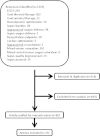Meta-analysis of protocolized goal-directed hemodynamic optimization for the management of severe sepsis and septic shock in the Emergency Department
- PMID: 24696750
- PMCID: PMC3952890
- DOI: 10.5811/westjem.2013.7.6828
Meta-analysis of protocolized goal-directed hemodynamic optimization for the management of severe sepsis and septic shock in the Emergency Department
Abstract
Introduction: To perform a meta-analysis identifying studies instituting protocolized hemodynamic optimization in the emergency department (ED) for patients with severe sepsis and septic shock.
Methods: We modeled the structure of this analysis after the QUORUM and MOOSE published recommendations for scientific reviews. A computer search to identify articles was performed from 1980 to present. Studies included for analysis were adult controlled trials implementing protocolized hemodynamic optimization in the ED for patients with severe sepsis and septic shock. Primary outcome data was extracted and analyzed by 2 reviewers with the primary endpoint being short-term mortality reported either as 28-day or in-hospital mortality.
Results: We identified 1,323 articles with 65 retrieved for review. After application of inclusion and exclusion criteria 25 studies (15 manuscripts, 10 abstracts) were included for analysis (n=9597). The mortality rate for patients receiving protocolized hemodynamic optimization (n=6031) was 25.8% contrasted to 41.6% in control groups (n=3566, p<0.0001).
Conclusion: Protocolized hemodynamic optimization in the ED for patients with severe sepsis and septic shock appears to reduce mortality.
Conflict of interest statement
Figures



References
-
- Friedman G, Silva E, Vincent JL. Has the mortality of septic shock changed with time? Crit Care Med. 1998;26:2078–2086. - PubMed
-
- Martin GS, Mannino DM, Eaton S et al. The epidemiology of sepsis in the United States from 1979 through 2000. N Engl J Med. 2003;348:1546–1554. - PubMed
-
- Fromm R, Gibbs L, McCallum W et al. Critical care in the emergency department: a time based study. Crit Care Med. 1993;21:970–976. - PubMed
-
- Wang HE, Shapiro NI, Angus DC et al. National Estimates of Severe Sepsis in United States Emergency Departments. Crit Care Med. 2007;35:1928–1936. - PubMed
-
- Angus DC, Linde-Zwirble WT, Lidicker J et al. Epidemiology of severe sepsis in the United States: Analysis of incidence, outcome, and associated costs of care. Crit Care Med. 2001;29:1303–1310. - PubMed
Publication types
MeSH terms
LinkOut - more resources
Full Text Sources
Other Literature Sources
Medical

